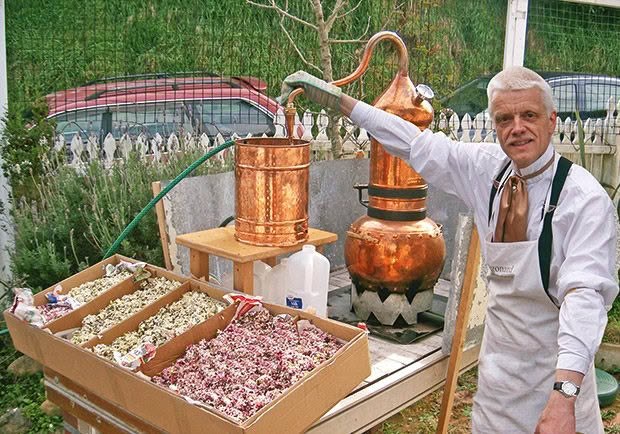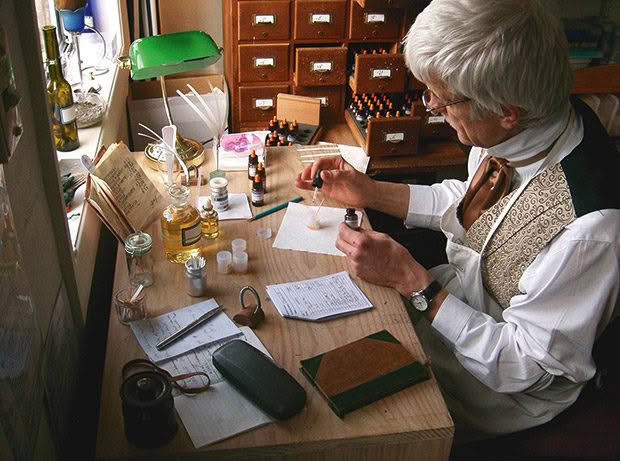Victorian perfume in Wellington: Francesco van Eerd is dedicated to perfumery as it was done 100 years ago

Forester by training, teacher by career, Francesco van Eerd found his true calling distilling, blending and selling perfumes with fragrant Victorian flair.
Words Lee-Anne Duncan
Francesco van Eerd has always enjoyed aroma. As a young forestry student, he wrote his thesis on perfumery products that come from 387 trees and shrubs. But never did he ever consider becoming a perfumer.
“My professor did suggest I do practical training in perfumery. But that would have meant going to France for another three years of schooling, and I’d had enough. I was 26 and wanted to get out into the real world.” Soon after, he met his Lower Hutt-bred (and now former) wife in Scotland, and then moved to New Zealand.
But Francesco’s timing was off. He arrived in New Zealand in 1986, two weeks after the government privatized the Forestry Department, causing 16,000 forestry workers to jostle for employment. Francesco applied for 187 jobs in 18 months.
“I first applied for forestry jobs, then anything to do with parks and greens, then anything outside. But I got nothing.” Eventually, a friend suggested teaching, so he taught science, then computer science. Years later, when his children left home and his marriage dissolved, “the perfume bug started biting again”.
Francesco traveled to Grasse, in France, the world’s perfumery capital, for some training at Fragonard, one of the city’s 35 perfumeries. While he liked what he saw — the traditional methods and Victorian vibe — the training was expensive, and not what he wanted.
Back in New Zealand, Francesco discovered the work of British perfumer Steven Dowthwaite, who agreed to come to New Zealand to teach a practical course in perfumery. In 2012, Francesco left teaching, dedicating himself to making and selling perfumes.
Although he started small — selling in markets — his shop, Fragrifert Parfumeur, the Victorian Perfumery, has been at the top of Wellington’s Cable Car since 2013. “It’s perfumery as it was done 100 years ago,” he says to all his customers by way of introduction. The shop’s interior is heavy on the Victorian theme — Francesco is always impeccable in a Victorian three-piece suit and puff tie — and the handy perfumer has constructed it all himself.

Likewise, he makes all Fragrifert’s perfumes. While that requires a good nose and a great memory, it also takes patience. “I never get the first version right. So it’s a matter of starting somewhere and making versions until I get it right. It can take five or six months to formulate a new perfume, partly because there’s no ‘undo’ button. If I add a couple of drops of patchouli, rose, or nutmeg, and it’s not as good as I’d hoped, I can’t take it out and mask it with something else. I must start again.”
Francesco says the Victorian vibe and way of working suit him as he’s “old-fashioned” in his tastes. “I don’t like most modern perfumes, which are virtually 100 per cent synthetic.” Synthetics do have a place, however, as they’re easier to control for allergens, which are numerous in natural materials.
Synthetics also replace “animalic” perfume ingredients, such as ambergris (from sperm whales), civet (from civets), musk (musk deer), and castoreum (from beavers). “I use only manmade replacements for those as the natural materials are bad news for the animals, and chemists create good copies.”
Ever the teacher, Francesco teaches perfumery to chemical design students at the University of Canterbury and runs workshops at Fragrifert, nurturing perfume hobbyists. “With a basic set of materials — that’s only 50 or so, not the 764 I have — anyone can make lovely perfumes.”
PRODUCING PERFUME
Francesco van Eerd’s perfumes are made with a high percentage of plant-based extracts, 35 of which he hand-distils, one plant at a time, in one of his copper stills. Many are distinctly Aotearoa — gorse, tarata (lemonwood), kauri, harakeke, taramea (speargrass), and feijoa (which smells amazing). Starting with three bathtubs full of plant material, he reaps only 50ml of essential oil — but it’s enough to make perfumes for four months or so.
The tiny dropper bottles with essential oils and absolutes are stored in his fascinating “perfumer’s organ”, its numerous drawers holding 764 mysterious ingredients.
To blend perfumes, Francesco mixes minute amounts of the highly concentrated oils (his favourite is labdanum, from the leaves of the rock rose), selecting what his nose and experience tells him will work together. After many variations, he arrives at a “compound” he’s happy with; it’s diluted in almond oil or alcohol to be sold as one of his 29 perfumes. buyperfumeonline.co.nz
Love this story? Subscribe now!
 This article first appeared in NZ Life & Leisure Magazine.
This article first appeared in NZ Life & Leisure Magazine.
